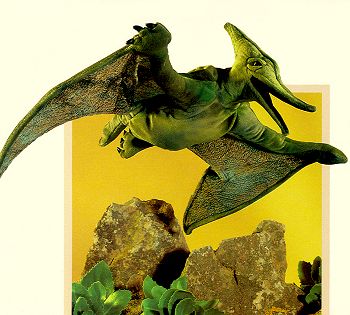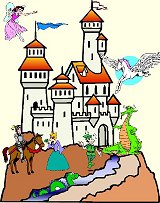|

|
Stuffed
Pteranodon
A
premium quality stuffed pteranodon, a winged dinosaur, from Folkmanis that doubles as a hand puppet!
18
Inches Long
Folkmanis Stuffed Pteranodon
FM2365
$26.50
Sold Out
Discontinued
14 Dec 08
|
|
Folkmanis offers stuffed
animals with a special bonus -
they come alive as hand puppets. For teaching, story telling,
or just plain fun, free your imagination with Folkmanis!
|
|
|
Pteranodon
-
flying
reptile (pterosaur)
found as fossils in North American deposits dating from about 90
million to 100 million years ago during the Late Cretaceous Period.
Pteranodon had a wingspan
of 7 metres (23 feet) or more, and its toothless jaws were very long
and pelican-like.
A crest at the back of
the skull (a common feature among pterosaurs) may have functioned in
species recognition; the crest of males was larger. The crest is often
thought to have counterbalanced the jaws or have been necessary for
steering in flight, but several pterosaurs had no crests at all. As
compared with the size of the wings, the body was small (about as
large as a turkey), but the hind limbs were relatively large compared
with the torso. Although the limbs appear robust, the bones were
completely hollow, and their walls were no thicker than about one
millimetre. The shape of the bones, however, made them resistant to
the aerodynamic forces of flight.
Pteranodon, like other pterosaurs, was a strong flier with
a large breastbone, reinforced shoulder girdles, and muscular
attachments on the arm bones—all evidence of power and
maneuverability. However, as in the largest present-day birds,
Pteranodon's large size
precluded sustained beating of the wings, so it most likely soared
more than it flapped. The eyes were relatively large, and the animal
may have relied heavily upon sight as it searched for food above the
sea.
Fossils of
Pteranodon and related
forms are found in Europe, South America, and Asia in rocks formed
from substances found in marine environments, which supports the
inference of a pelican-like lifestyle. It is probable that
Pteranodon took off from
the water by facing into sea breezes that provided enough force to
lift the reptile into the air when the wings were spread.
"pteranodon" Encyclopædia Britannica
from Encyclopædia Britannica Premium Service. |
|

